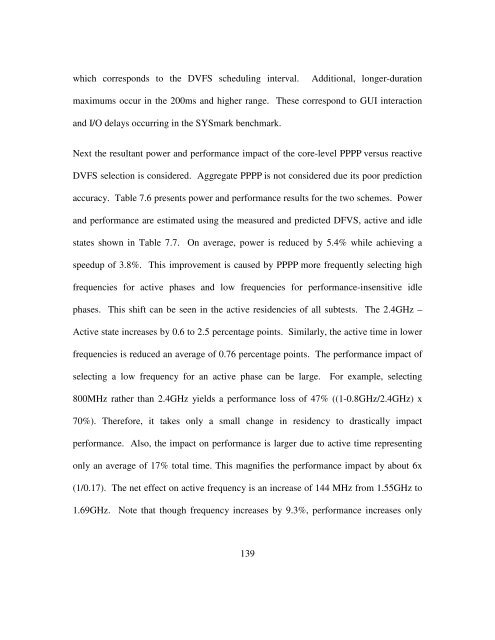Copyright by William Lloyd Bircher 2010 - The Laboratory for ...
Copyright by William Lloyd Bircher 2010 - The Laboratory for ...
Copyright by William Lloyd Bircher 2010 - The Laboratory for ...
You also want an ePaper? Increase the reach of your titles
YUMPU automatically turns print PDFs into web optimized ePapers that Google loves.
which corresponds to the DVFS scheduling interval. Additional, longer-duration<br />
maximums occur in the 200ms and higher range. <strong>The</strong>se correspond to GUI interaction<br />
and I/O delays occurring in the SYSmark benchmark.<br />
Next the resultant power and per<strong>for</strong>mance impact of the core-level PPPP versus reactive<br />
DVFS selection is considered. Aggregate PPPP is not considered due its poor prediction<br />
accuracy. Table 7.6 presents power and per<strong>for</strong>mance results <strong>for</strong> the two schemes. Power<br />
and per<strong>for</strong>mance are estimated using the measured and predicted DFVS, active and idle<br />
states shown in Table 7.7. On average, power is reduced <strong>by</strong> 5.4% while achieving a<br />
speedup of 3.8%. This improvement is caused <strong>by</strong> PPPP more frequently selecting high<br />
frequencies <strong>for</strong> active phases and low frequencies <strong>for</strong> per<strong>for</strong>mance-insensitive idle<br />
phases. This shift can be seen in the active residencies of all subtests. <strong>The</strong> 2.4GHz –<br />
Active state increases <strong>by</strong> 0.6 to 2.5 percentage points. Similarly, the active time in lower<br />
frequencies is reduced an average of 0.76 percentage points. <strong>The</strong> per<strong>for</strong>mance impact of<br />
selecting a low frequency <strong>for</strong> an active phase can be large. For example, selecting<br />
800MHz rather than 2.4GHz yields a per<strong>for</strong>mance loss of 47% ((1-0.8GHz/2.4GHz) x<br />
70%). <strong>The</strong>re<strong>for</strong>e, it takes only a small change in residency to drastically impact<br />
per<strong>for</strong>mance. Also, the impact on per<strong>for</strong>mance is larger due to active time representing<br />
only an average of 17% total time. This magnifies the per<strong>for</strong>mance impact <strong>by</strong> about 6x<br />
(1/0.17). <strong>The</strong> net effect on active frequency is an increase of 144 MHz from 1.55GHz to<br />
1.69GHz. Note that though frequency increases <strong>by</strong> 9.3%, per<strong>for</strong>mance increases only<br />
139




